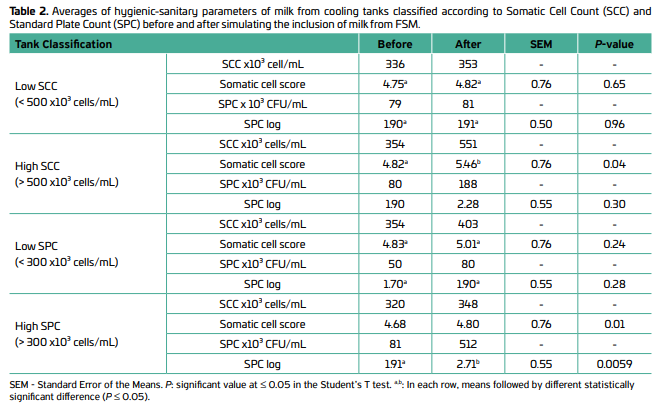Evaluation of forestripping milk and its effects on milk quality
DOI:
https://doi.org/10.21708/avb.2022.16.1.10334Resumen
Consumers demand for food safety affects dairy industry, restraining the sector to adapt to milk quality parameters established by legislation, such as somatic cell count (SCC) and standard plate count (SPC). Good agricultural practices have positive impact over these parameters, especially Forestripping Milk (FSM), which consists of observing the first milk streams collected in a dark-bottomed mug for identification of clinical mastitis. These first milk streams have high somatic cells count and bacteria. Therefore, the aim of this study was to evaluate the characteristics of milk from FSM, such as SCC and SPC values, and its impacts on milk quality of the cooling tank through simulating contamination. Fourteen dairy farms and one experimental farm were evaluated for SCC and SPC parameters of FSM. It was observed that there was no statistically significant difference for SCC and SPC between milk samples from the cooling tank and cooling tank simulating the inclusion of milk from FSM. Statistically significant difference for somatic cell score (SCS) and SPC was observed when tanks were classified by SCC. In addition, difference in SCS was observed between morning and afternoon milking. The collection of first milk streams can contribute to decrease in SCC and SPC of milk in the cooling tank. FSM must be practiced by all dairy farmers as milking management, to assist in clinical mastitis diagnosis and improve milk quality.
Descargas

Descargas
Publicado
Número
Sección
Licencia
Autores que publicam na Acta Veterinaria Brasilica concordam com os seguintes termos: a) Autores mantém os direitos autorais e concedem à revista o direito de primeira publicação, com o trabalho simultaneamente licenciado sob a Licença Creative Commons Attribution que permite o compartilhamento do trabalho com reconhecimento da autoria e publicação inicial nesta revista. b) Autores têm autorização para assumir contratos adicionais separadamente, para distribuição não-exclusiva da versão do trabalho publicada nesta revista (ex.: publicar em repositório institucional ou como capítulo de livro), com reconhecimento de autoria e publicação inicial nesta revista. c) Autores têm permissão e são estimulados a publicar e distribuir seu trabalho online (ex.: em repositórios institucionais ou na sua página pessoal) a qualquer ponto antes ou durante o processo editorial, já que isso pode gerar alterações produtivas, bem como aumentar o impacto e a citação do trabalho publicado (Veja O Efeito do Acesso Livre).


 Esta obra está licenciada com uma Licença
Esta obra está licenciada com uma Licença 